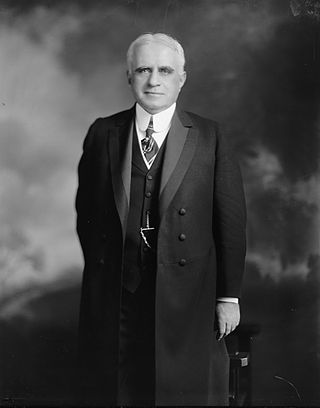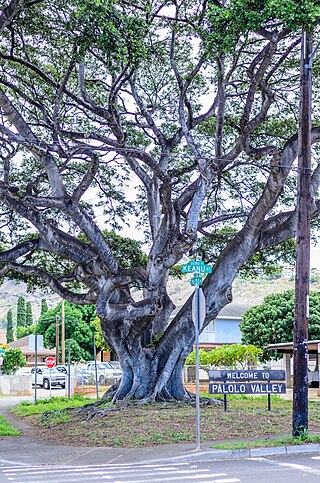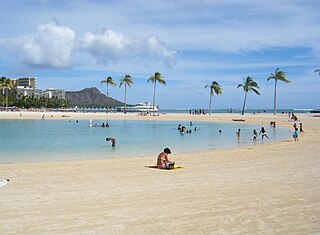
Honolulu is the capital and most populous city of the U.S. state of Hawaii, which is in the Pacific Ocean. It is the unincorporated county seat of the consolidated City and County of Honolulu, situated along the southeast coast of the island of Oʻahu, and is the westernmost and southernmost major U.S. city. Honolulu is Hawaii's main gateway to the world. It is also a major hub for business, finance, hospitality, and military defense in both the state and Oceania. The city is characterized by a mix of various Asian, Western, and Pacific cultures, reflected in its diverse demography, cuisine, and traditions.

Waikiki is a Honolulu neighborhood and its eponymous beach on the south shore of the island of Oʻahu in the U.S. state of Hawaii.

The Ala Moana Center, commonly known simply as Ala Moana, is a large open-air shopping mall in the Ala Moana neighborhood of Honolulu, Hawaii. Owned by Brookfield Properties, Ala Moana is the eighth largest shopping mall in the United States and the largest open-air shopping center in the world.

Walter Francis Dillingham called the Baron of Hawaii Industry, was an industrialist and businessman from Honolulu, Hawaii. He gained favors from Hawaii politicians to develop urban Honolulu.

Ala Moana Beach Park is a free public park on the island of Oahu, U.S. state of Hawaii, located between Waikiki and downtown Honolulu. This 100-acre (0.40 km2) park has a wide gold-sand beach that is over a half-mile long.

Kakaʻako is a commercial and retail district of Honolulu, Hawaiʻi between Ala Moana near Waikīkī to the east and downtown Honolulu and Honolulu Harbor to the west. Kakaʻako is situated along the southern shores of the island of Oʻahu, Hawaiʻi.

Manoa is a valley and a residential neighborhood of Honolulu, Hawaiʻi. The neighborhood is approximately three miles east and inland from downtown Honolulu and less than a mile from Ala Moana and Waikiki.

Lucius Eugene Pinkham was the fourth Territorial Governor of Hawaii, serving from 1913 to 1918. Pinkham was the first member of the Democratic Party of Hawaii to become governor.

Charles James McCarthy was the fifth Territorial Governor of Hawaii and served from 1918 to 1921.

Ala Moana is a commercial, retail, and residential district of Honolulu, Hawaii. It is located between Waikiki and Moiliili to the east, and Kakaʻako and Honolulu Harbor to the west. King Street, to the north, marks the border with the neighborhood of Makiki.

Kewalo Basin is a commercial boat harbor that serves as home to some of Honolulu's commercial fishing fleet, and charter and excursion vessels that serve the Hawaii tourist market. Pre-European contact, the area was historically used for human sacrifice. The land was given to Ihu by Kamehameha I and inherited by his daughter Kamakeʻe and her husband Jonah Piikoi. On the ocean side of the harbor is a small beach park on the Honolulu waterfront, located adjacent to the larger Ala Moana Beach Park. This park is good for swimming, picnicking and sightseeing. It can be accessed from the corners of Ala Moana Boulevard and Ward Avenue.

Pālolo is the name of a valley, stream, and residential neighborhood in Honolulu, Hawaii, the United States. The area lies approximately four miles east and inland from downtown Honolulu, less than a mile from Diamond Head. Like many of Hawaii's neighborhoods, Pālolo consists of an entire valley. The mauka (mountain-side) of the valley is agricultural in nature. The makai (ocean-side) of the valley ends approximately at Waiʻalae Avenue and is densely settled, mostly with single-family homes.

Route 92 is a major east–west highway on the island of Oahu which begins at exit 15 off Interstate H-1 (H-1) in Honolulu. The western end of the highway is located at the gate to Joint Base Pearl Harbor–Hickam and the eastern end is 0.6 miles (0.97 km) east of the Ala Wai Canal crossing in Waikiki. The western portion of the highway, west of Richards Street, is named the Nimitz Highway. East of Richards Street, Route 92 is also known as Ala Moana Boulevard.

The Ala Moana Hotel is a hotel in Honolulu, Hawaii, opened in 1970. It adjoins the Ala Moana Shopping Center and is across the street from the Hawaii Convention Center as well as the Ala Moana Beach Park.

The Kakaʻako Pumping Station in Honolulu, Hawaii was designed by architect Oliver G. Traphagen in the Richardsonian Romanesque style. He also designed many such bold stone public works buildings in Duluth, Minnesota.

Duke Paoa Kahanamoku Lagoon is a small, man-made wading pool in the Waikiki neighborhood of Honolulu, on the south shore of the island of Oʻahu near the Ala Wai Small Boat Harbor and Fort DeRussy Military Reservation. The Hilton Hawaiian Village is adjacent to the lagoon.

Ala Wai Harbor is the largest small boat and yacht harbor in Hawaii. The harbor is situated in Honolulu at the mouth of the Ala Wai Canal, between Waikiki and downtown Honolulu. To the east are Waikiki and Diamond Head; to the west, Magic Island and the Honolulu waterfront.
Donald Houston Graham Jr. was an American real estate developer and businessman credited with transforming the urban landscape of Hawaii by building condos, resorts, hotel, residences and shopping centers. He developed and constructed the Ala Moana Center in Ala Moana, which opened in 1959 and remains the largest outdoor shopping mall in the United States.

Kalākaua Avenue is a street in Honolulu in the US federal state of Hawaii. The street travels across the tourist Centre of Waikīkī and belongs to the prospering streets of the United States. It demonstrates an architectural fusion of Hawaiian, Gothic, Asian, Spanish and Moorish architecture.





















